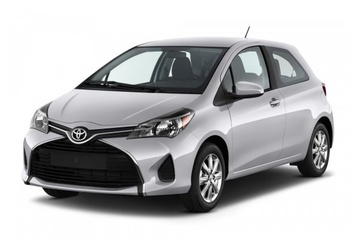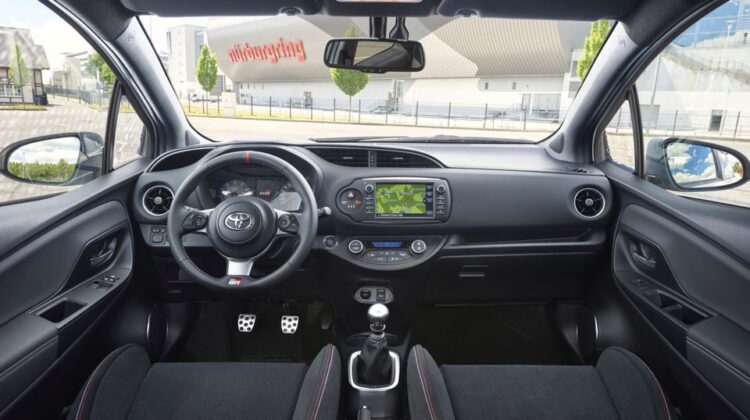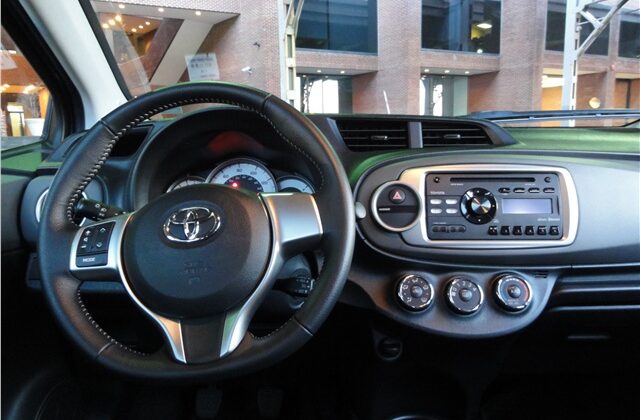2013 Toyota Yaris XP130
The interior of the Toyota Yaris XP130 was a significant step forward from previous generations, offering a more refined and modern driving experience. Here’s a breakdown of its key aspects:
Space and Comfort:
- Spacious Cabin: The XP130 offered more legroom and headroom for both front and rear passengers compared to the XP90.
- Comfortable Seats: The seats were well-padded and supportive, providing a comfortable ride for both short and long journeys.
- Improved Visibility: The larger windows and higher seating position provided excellent visibility, making it easier to navigate in urban environments.
Features:
- Modern Dashboard: The dashboard was redesigned with a more modern and driver-focused layout. It featured a clear instrument cluster and easy-to-use controls.
2013 Toyota Yaris XP130 Interior
- Standard Features: The XP130 came standard with features like power steering, power windows, air conditioning, and a CD player.
- Optional Features: Depending on the trim level and market, optional features included a touchscreen infotainment system with navigation, Bluetooth connectivity, a rearview camera, and a sunroof.
- Cargo Space: The XP130 offered a decent amount of cargo space, which could be further expanded by folding down the rear seats.
Technology:
- Infotainment System: Higher trim levels featured a touchscreen infotainment system with Bluetooth connectivity, allowing for hands-free calling and music streaming.
- Safety Technology: Some models offered advanced safety features like lane departure warning, automatic emergency braking, and a rearview camera.
Overall:
The interior of the Toyota Yaris XP130 was a significant improvement over its predecessors. It offered a more comfortable, modern, and technologically advanced driving experience.
2013 Toyota Yaris XP130
The Toyota Yaris XP130 offered a range of engine options, catering to different needs and preferences. Here’s a breakdown of the available engines:
1.0-Liter 3-Cylinder Engine:
- Power: This engine produced around 69 horsepower (hp) and 95 Nm of torque.
- Fuel Efficiency: It was known for its excellent fuel economy, making it a popular choice for city driving and commuting.
- Performance: While not particularly powerful, it provided adequate performance for everyday driving.
1.3-Liter 4-Cylinder Engine:
- Power: This engine offered more power, producing around 99 hp and 127 Nm of torque.
- Performance: It provided a noticeable improvement in acceleration and overall performance compared to the 1.0-liter engine.
- Fuel Efficiency: While still fuel-efficient, it was slightly less economical than the smaller engine.
1.5-Liter 4-Cylinder Engine:
- Power: This engine was the most powerful option, producing around 109 hp and 141 Nm of torque.
- Performance: It provided the best acceleration and overall performance in the Yaris XP130 lineup.
- Fuel Efficiency: It was the least fuel-efficient option, but still offered decent mileage for its power output.
Transmission Options:
- 5-Speed Manual Transmission: This was the standard transmission for most models.
- 4-Speed Automatic Transmission: This was available as an option on some models, offering convenience for city driving.
Note: Engine options and availability varied depending on the market and trim level. Some markets might not have offered all engine choices.
You’re right to be curious about the 1.0-liter engine’s performance, as it’s the smallest option in the Yaris XP130 lineup. While it’s not a powerhouse, it’s designed to be fuel-efficient and suitable for everyday driving. Here’s a breakdown of how it compares to the other options:
1.0-Liter 3-Cylinder Engine:
- Acceleration: It’s not the quickest, taking a bit longer to accelerate from 0-60 mph compared to the 1.3-liter and 1.5-liter engines. However, it’s still adequate for city driving and merging onto highways.
- Highway Performance: It’s not as comfortable at higher speeds, especially when overtaking or climbing hills. You might need to downshift more frequently to maintain speed.
- Overall Feel: It’s not as spirited as the larger engines, but it’s perfectly capable for everyday driving, especially in urban areas.
Comparison with 1.3-Liter and 1.5-Liter Engines:
- Acceleration: The 1.3-liter and 1.5-liter engines offer noticeably quicker acceleration, making them more enjoyable for spirited driving and overtaking.
- Highway Performance: The larger engines are more comfortable at higher speeds and provide better passing power.
- Overall Feel: The 1.3-liter and 1.5-liter engines offer a more energetic and responsive driving experience.
Key Points to Remember:
- Fuel Efficiency: The 1.0-liter engine is the most fuel-efficient option, making it a great choice for those prioritizing economy.
- Driving Style: If you mainly drive in the city and prioritize fuel efficiency, the 1.0-liter engine is a suitable choice. If you want more power and enjoy spirited driving, the 1.3-liter or 1.5-liter engines are better options.
- Market Availability: The 1.0-liter engine was more commonly available in some markets, while others might have focused on the larger engine options.
- +Adaptive Cruise Control
- +Air conditioning
- +Alloy wheels
- +ESC
- +ESP
- +Keyless Entry
- +Leather Seats
- +Panoramic Sunroof
- +Power-adjustable Seats
- +Rearview Camera
- +TC






Leave a Reply